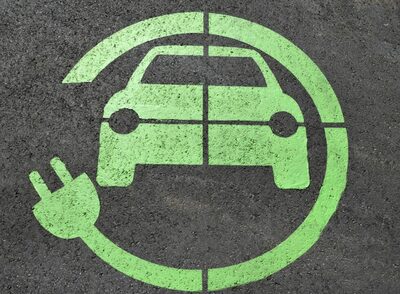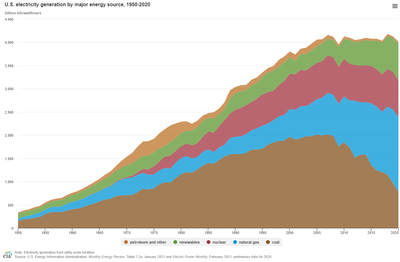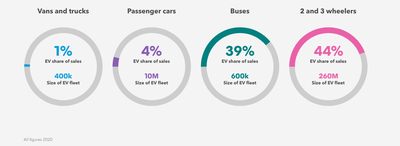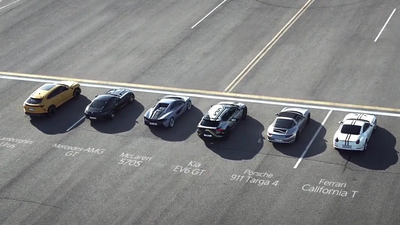The Auto Channel Fair and Balanced: Electric Vehicle Myths Debunked By Electrify Expo
 |
So, it’s time to sit back, relax, and let the information flow into your eyeballs as we debunk some of the most persistent myths about EVs. Enjoy!
Myth 1: Electric vehicles are ‘dirty’, producing as many carbon dioxide emissions as a combustion vehicle
Like a lot of the myths we talk about here, this one sounds like it might be true at first glance—and that’s what makes these myths so persistent: if you like soundbites, but don’t like research (ProTip: YouTube isn’t research), you might fall for something like this. “Just think of all the pollution that comes from digging for the minerals used in electric car batteries,” they say. Or, another variant on this, “the electricity still comes from coal and fossil fuels, so you’re just moving the emissions from the tailpipe to somewhere else.”
The reality is that, while there may have been a grain of truth to these claims a decade or so ago, modern EV battery materials are often mined using provably sustainable techniques, low-emissions equipment, and get transported minimal distances by high-efficiency rail. What’s more, we’re making breakthroughs in recycling those materials that were almost unimaginable back in—I dunno, let’s say 2005. In the decade and a half since, America’s energy production grid has gotten significantly “greener”, and we’re using half as much coal and petroleum to generate electricity in 2020 as we did back then—and we’re generating more electricity overall, as well. Don’t take my word for it, though—here’s the math coming straight from the EIA.
Over the course of those same fifteen years, we’ve also learned that how internal combustion cars behave in the real world often leads to pollution that’s many times worse than what we, as consumers, were originally led to believe—and that doesn’t just apply to diesel, but to just about every other combustion-based energy source as well, from “clean coal” to LPG.
And, like, windmills can’t set the ocean on fire. (Just sayin’.)
Myth 2: Electric vehicles are not suited to long journeys
This is another example of outdated, fear-based information that simply doesn’t hold up to scrutiny—and the best way to see that for yourself is to go download an app called Chargeway.
If you’re here at Electrify Expo and reading about EVs, you’ve probably heard of Chargeway, since Matt Teske—one of the hosts of the Electrify Expo Podcast—designed the app specifically to enhance the ownership experience of an electric car and replace “range anxiety” with Range Confidence™. With Chargeway, you can simply select the type of car you drive, enter your location, and plan a trip using real-world temperature and driving speed data, as well as up-to-date, network agnostic information about the best places to charge the EV you’re looking at.
What does “network agnostic” mean? Well, when you look at a charging map from one of the major charging networks, they’ll only show the charging stations on their network—and that might make a long road trip seem impossible, if they don’t own all the chargers along the way. An app like Chargeway, that isn’t owned by one of the networks, can show you chargers across all the major networks, and even provide payment instructions, charging time, and pictures of the charging stations ahead of time.
To prove out his app, Matt recently drove his personal electric car from Portland, OR to Chicago, IL and back along two different routes, covered 4400 miles in five days, and tweeted about it at every charging stop. Fun fact: Matt’s longest charging stop was about 30 minutes. Check it out!

Myth 3: There are not enough public charging stations
This one feels kind of similar to the long-distance driving one, but strikes a little closer to home. The reality is that more than 95% of the charging someone will do with an electric vehicle will probably be at home, through a standard 110 or 220 wall outlet.
That’s right: you don’t need a special charging station or fast charger to “top off” your tank at home. You just plug your electric car into a standard outlet, and let it juice up overnight. In many cases, you’ll wake up with a full tank of electrons, even if you don’t have a special charger in your garage. Add to that the fact that there are more than 40,000 public charging stations in the US as I type this (with many more to come) and you’ll start to see even more flaws in this myth’s “logic”.
Myth 4: The grid cannot support an increase in electric vehicle charging
I like to tell people that lotteries are a tax on people who are bad at math, and I’d be willing to bet that the people who talk about the charging grid being unable to handle EVs probably have a few Powerball tickets in their glove compartments. The reality is that EVs only account for 2.6% of global car sales and about 1% of the global car stock in 2019. Until
I emphasised the “current” grid, because our national energy grid, as we already pointed out, has been through some dramatic changes in recent years. Changes that will only continue to accelerate the sustainability and durability of the grid as technology improves.
Finally, companies like Nissan, Ford, and Tesla—with many more sure to follow!—have already debuted technology called V2G, or vehicle-to-grid. There’s a lot to read about on the topic, but the short version is that the electrons stored in your car’s battery are the same kind used to power your refrigerator, tv, or wifi. In the event of a natural disaster or grid failure due to extreme weather like the ice storms we saw in Texas last year, a vehicle like the Ford F150 Lightning could be used to keep the lights on for days at a time, without the carbon monoxide poisoning and noise pollution of a gas generator. When an electric vehicle is plugged into its charger this way, it can actually help support the grid, keeping the lights on when they’d otherwise go out.
Myth 5: EVs are too expensive
Real talk, everything is stupid expensive these days-- but electric vehicles? Whether you’re talking e-bikes or automobiles, the reality is that electric vehicles are less expensive to own, less expensive to maintain, and—yes, even less expensive to actually purchase than you probably realize.
Let’s look at a few examples of what I mean, starting with electric cars. The average transaction price of a new car in the United States in 2020 was $40,107. That’s the average, not the median—meaning it takes all those hundreds of Bentleys and Ferraris and waters them down with all those hundreds of thousands of trucks and SUVs and Camcords, too. And, amid all of that, the starting price of a new Ford F-150 Lightning electric pickup is just $41,669 … and that’s before the $7500 Federal tax credit for EVs and any state, municipal, or local utility company rebates kick in. When it’s all said and done, that state-of-the art pickup might sell for under $35,000, or well below the average price of a new car. The Tesla Model 3? $39,990, which is still just a tick below average. Want something a little sportier? The all-electric mini Cooper SE hardtop starts at $29,900, also before rebates.
On the two wheeled side it’s more of the same, with Specialized offering its Turbo Creo SL Comp E5 electrified road bike for about $6000 on its website, compared to $12,500 for a Roubaix SRAM Red model … and my big butt will go a lot farther, a lot faster on the e-bike, I promise!
Conclusions
If you’ve gotten this far still believing some of these popular EV myths, I’m not sure how to help you. I could take the low road, attack the credibility of your sources, tell you to get smarter friends, mention that Joe Rogan is just what happens when you confuse “having thoughts” with “being smart”, but I won’t do any of those things. I’ll simply ask you to pick the track, bring your favorite mid-engine, V12 powered compensator, and line up alongside me in an electric car. If watching a family hatchback Kia blow the doors off a Lamborghini doesn’t make you give electric cars a second look, maybe they were always too good for you, anyway. ;)






